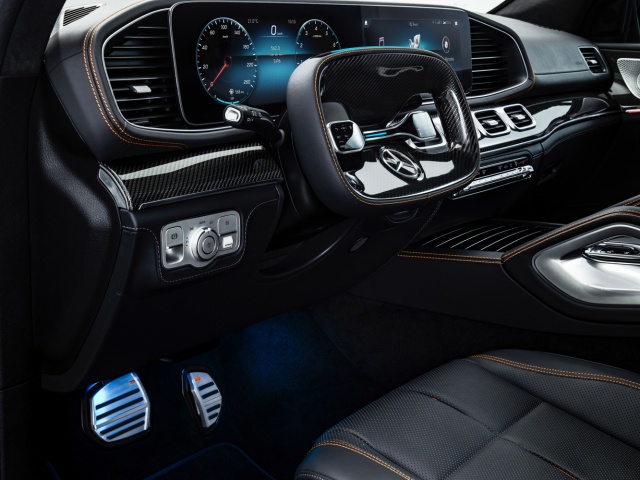What's the news?
Mercedes is showing off its latest thinking on safety technology with the latest of its long-line of ESF experimental safety vehicles. Due to be shown off at the ESV convention in Eindhoven in June, ahead of a bigger debut at the Frankfurt motor show later this year, the ESF 2019 is based on the new GLE SUV.
It's the forthcoming plug-in hybrid model, in fact, but hugely modified from standard. The biggest change is the fact that, in autonomous mode, the steering wheel and pedals retract away into the dashboard, meaning that there are fewer hardpoints for the driver to hit in the event of a crash. Mercedes has also re-worked the car's airbag setup so that the systems still work properly with the wheel tucked away - the driver's main airbag moves to the dashboard, while the side airbags are now located it the side bolsters of the seats.
There's also active safety for the driver when they're in control - there's a light built into the sun-visor that can replicate the effect of natural daylight, helping to keep you more alert and responsive on gloomy, cloudy days.
On the outside, the car is festooned with sensors that help it navigate its environment when in autonomous mode, but they also include exterior display screens that can communicate with other road users, so as to let them know what the ESF is going to do next. The screens can display a combination of animations and symbols, and flash red when there's something dangerous going on. They can also send signals to other traffic, allowing cars to merge into traffic ahead of the ESF. The system can even work when the ESF is parked up, potentially warning other cars of a pedestrian about to step out into the road.
The ESF 2019 also has the latest in headlight technology, which uses Digital Light LEDs to provide what Mercedes calls "practically dazzle-free high beam in HD quality and a resolution of more than two million pixels."
Inside, there's a special Pre-Safe Child car safety seat, which gets its own pre-tensioner seatbelts (which can hold a child firmly in place in the case of an accident) and extra side impact protection bars that extend from the sides if the car detects an accident about to happen.
The ESF might also, eventually, be equipped with a tiny drone robot, that can emerge from under the back bumper in the event of an accident, and which can position itself as a warning triangle behind the car. That can be added to by using the massive rear display screen, as well as a possible roof-mounted pop-up warning triangle.
There are also some seatbelt innovations, including an active pre-tensioner that tugs tight to warn the driver that they are approaching an upcoming corner too fast, plus seatbelt 'butler' arms for rear seat passengers, as well as illuminated belt buckles. Mercedes is also thinking about linking the rear USB ports to the seatbelt, only switching them on once the belt is fastened, incentivising rear seatbelt use.
On a bigger scale, the car's Pre-Safe system can, if it detects an imminent rear-end collision, jerk the car forward a few metres (assuming that there's space in front) to either avoid the collision or mitigate its effects. The forward movement also forces the occupants' heads back against their headrests, helping to reduce possible whiplash.
There's also an uprated autonomous emergency braking system that keeps an all-round watch for cyclists and which can jam on the anchors if you're about to turn across a cyclist who's in your blind spot.
"Safety is part of the brand DNA of Mercedes-Benz. We have repeatedly demonstrated that we are not short of ideas in this field since the 1970s, with our Experimental Safety Vehicles. The new ESF 2019 reflects the mobility of the future, and presents a wide variety of innovations which we are currently researching and developing. And I can already say this much: some of the functions are very close to series production," says Ola Källenius, Member of the Daimler AG Executive Board responsible for Mercedes-Benz Cars Development.
"Safety continues to be our core brand value," says Prof. Dr.-Ing. Rodolfo Schöneburg, Head of the Vehicle Safety, Durability and Corrosion Protection Centre at Mercedes-Benz Cars. "The great advantage of automating driving functions is that in the future, fewer accidents will be caused by driver error. However, automated and driverless vehicles also come up against physical limits, and there will undoubtedly be mixed traffic consisting of automated and non-automated vehicles for many years."

























